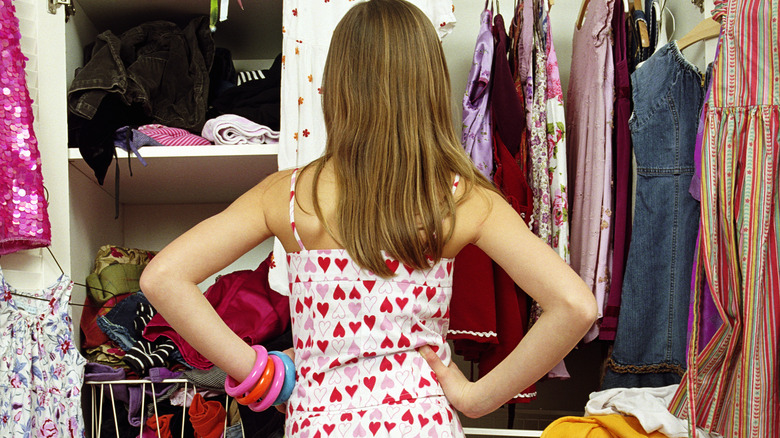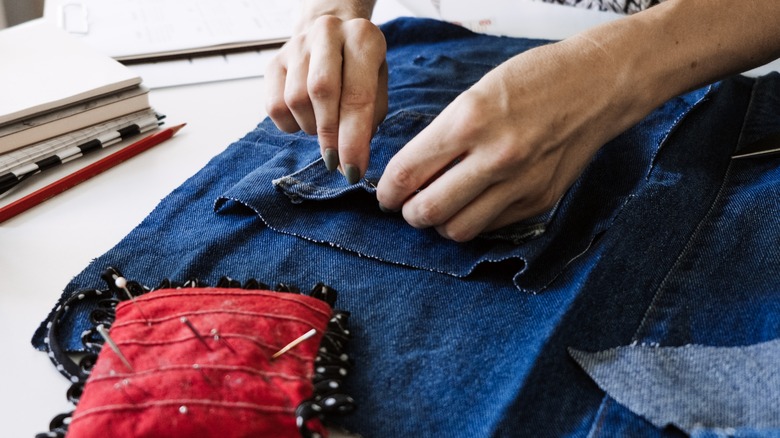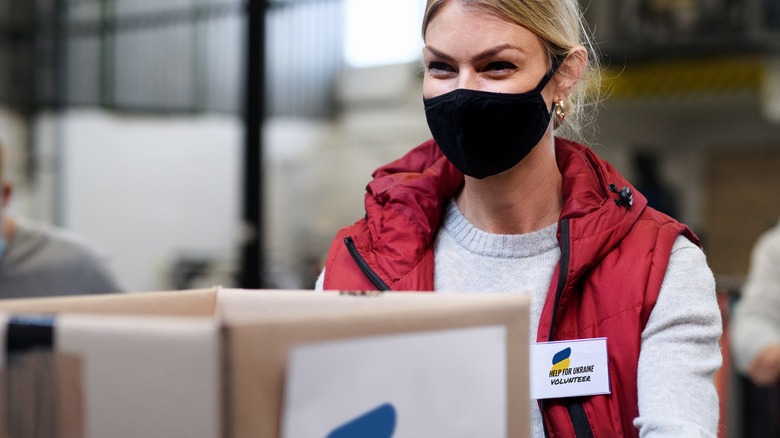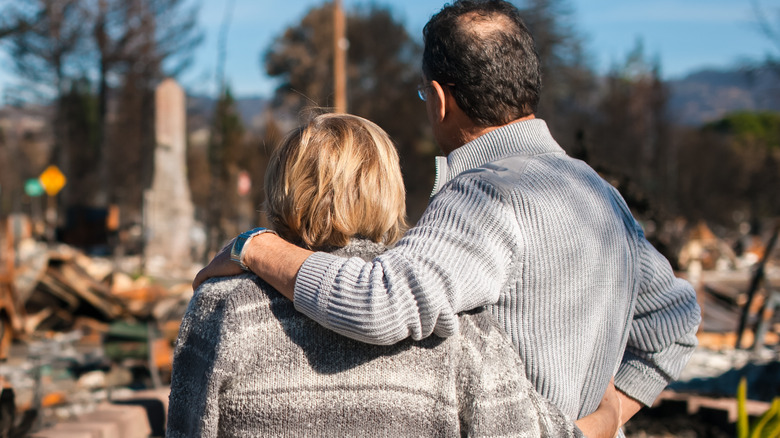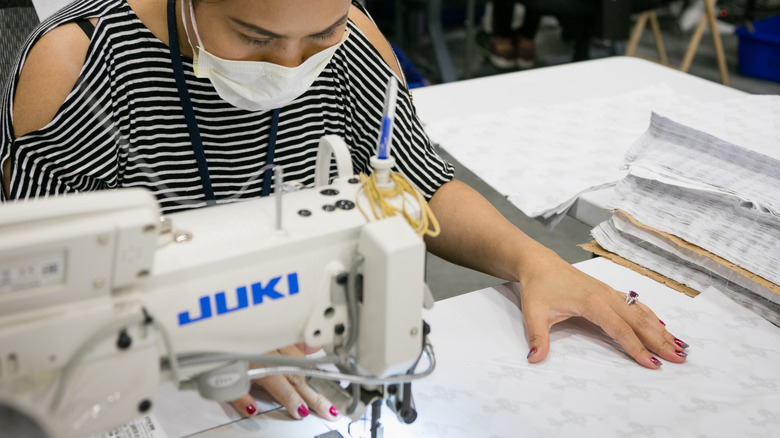How To Ensure Your Clothing Donations Are Doing Real Good
The digital era has turned shopping into a feeding frenzy. If you want to know what the modern consumerist narrative looks like, go to social media. What are the odds of people sharing photos of themselves in the same outfit twice? A 2017 Hubbub survey found that 41% of participants aged 18 to 25 feel pressured to not outfit-repeat every time they go out (via Metro). This fear of not being able to show the world that their taste in fashion is worth its weight in likes is why #outfitoftheday has been trending for years. And the price? A bunch of glad rags collecting dust. If you're one of those whose whims and fancies have outgrown their wardrobe space, don't feel judged! It takes a weary maximalist to raise a religious minimalist.
If your wardrobe is not sparking joy, it's time to declutter it. And to do so for a good cause is to donate the clothes that you don't need to charity. That sounds easy. But the U.S. Environmental Protection Agency said that 84% of unwanted clothing went to landfills (via Newsweek). Unless they're moldy or contaminated with hazardous substances, many donated clothes are sent to textile recyclers where they'll be chopped into rags and processed into raw materials to be used for other purposes. So, how do we make sure that our like-new fashion wears reach those who'll really get togged up in them? Here's how to ensure your clothing donations are fulfilling their destiny.
Sort out your donated clothes
Here are some dos and don'ts when it comes to deciding what stays and what goes. This process is important because not only does it help you declutter your closet effectively, but it also ensures that the clothes being given away meet the criteria of charity organizations that collect them. To prevent the need to purchase more, keep the essential and interchangeable articles of clothing that can be mixed and matched to create the most number of outfits.
Next is deciding on what not to give. Undies — no matter how cute or old they are — are generally a big no-no. You can try, but it's unlikely your local Salvation Army or Goodwill will accept them. However, if you're really keen to give your bras a second life, you can contact Free The Girls, an organization dedicated to helping and empowering survivors of sex trafficking. Old bras in good condition are also accepted by Support The Girls to be distributed to those in need.
Garments with visual defects like giant holes, moldy patches, and unremovable stains should be repurposed into cleaning rags or duvet covers or upcycled rather than being donated to other people to wear. Also, refrain from donating clothes that are not in season — like giving summer outfits during winter — because they're not in demand. After putting aside what you cannot donate, the donate list is narrowed down to clean and dry wearable pieces that people can really use.
Make your clothes look their best before donating them
Most charitable organizations prioritize accepting good-quality clothing contributions because they will sell the donated clothing and use the proceeds to support the less fortunate. That means, your clothing donations must have retail value in order to do real good.
For instance, when you donate clothes to Goodwill — home to over 3,000 thrift stores in the U.S. — workers will browse through your donations to determine what can be sold. According to Ray Tellez, Goodwill Southern California's vice president of retail operations (via HuffPost), retailers in his region monitor how long each piece of apparel has been on the sale floor. If a product does not sell within four weeks, it will be transferred to an outlet store where prices are super low to encourage sales, a live auction, or to a textile recycler if it still cannot be liquidated. The ultimate goal, according to Tellez, is to keep as much as possible out of landfills.
Many donated clothes are shipped overseas to be resold on a micro-level. If they still can't be sold, there's a possibility they'll end up in landfills. Therefore, make a point of mending and spot-treating them until they're as good as new. Keep in mind that the people who will buy your donated clothes could also be as price-aware and fashion-conscious as you. Before you donate clothing, take a look at each piece and ask yourself whether you would spend money to buy it.
Research groups to donate your clothes to
When it comes to finding places to donate your clothes to, The Salvation Army, Red Cross, and Goodwill are probably the first names that come to mind. However, it doesn't hurt to cast your nets wider and research nonprofit organizations and thrift stores that are more specific about the items that they accept to increase the chance of your donations making it to the hands of those who need them.
For instance, Becca's Closet, a non-profit organization that gifts formal dresses to high school students in need, accepts a variety of cocktail gowns, prom dresses, and accessories in good condition. Meanwhile, your professional clothing articles such as suits, button-down shirts, dark-colored skirts, and slacks will find themselves new owners at Dress for Success, an international non-profit organization with a mission of empowering women by equipping them with what they need to succeed, including professional garments.
Don't hesitate to schedule a pickup online with Vietnam Veterans of America if you want to donate gently used clothing, accessories, and other household items for adults and children. This nationwide nonprofit organization offers assistance and resources to the homeless and injured veterans as well as all military personnel returning home from deployment. If you'd like to donate your jewelry, ship it to Indigo Rescue, a non-profit and no-kill animal shelter that holds bi-annual jewelry sales to raise money to rescue stray animals.
Don't donate clothes to disaster relief efforts
This may come as a surprise: clothing donations are usually not welcomed at disaster relief organizations where emergency assistance is provided in the immediate aftermath of a disaster. A relief organization might call for donations of food, water, housing, clean-up initiatives, or other supplies depending on the circumstance. However, donating clothing is not a good idea unless a disaster relief organization explicitly requests it, says Miguel Jaller, co-director of the Sustainable Freight Research Program at the University of California at Davis (via The Washington Post). The reason being is they will not be useful, and relief organizations don't have volunteer resources to wade through, clean, and distribute clothing to those in need, Jaller explains.
The U.S. Federal Emergency Management Agency (FEMA) also states that "used clothing is rarely a useful item to collect and send into the disaster area," citing difficulties in cleaning, organizing, packing, transporting, storing, and distributing them to those who need extra help long-term. Heaps of clothing that cannot be used will only occupy the limited warehouse space required for other supplies and functions and hinder the relief efforts. As a result, they might end up in the dump alongside other disaster debris. If you really want to help disaster victims, FEMA suggests having a yard sale with used clothing to raise money for the disaster relief operations that cater to survivors.
Think about other alternatives
Suppose you are neither interested in donating nor recycling your unwanted clothes. In that case, the option that remains is to upcycle — a way of giving your clothes a new use in life by making use of what is still usable. If you're a quilter, Upcycle My Stuff recommends chopping up usable pieces of your old clothing to use in sewing crafts that use only random pieces of fabric. You can also cut your unwanted clothes up, paint or dye them, and patch the pieces into pillowcases, cleaning cloths, dusters, or even slinky tops. The options are aplenty, as long as you have some sewing skills.
One man's trash might be another pet's treasure. It's not a bad idea to donate your unused clothes to local animal shelters, where they can be repurposed into bedding materials and toys that provide warmth and comfort to stray animals. For instance, unused blankets, towels, and sheets can be beneficial in keeping furry friends toasty and happy, according to RSPCA South Australia. You can even go the extra mile and lace your old sweaters or cardigans into comfy pet mats or beds before sending them to the shelters. Animal shelters usually welcome a wide range of items; however, it's preferable to call them first and find out what they need and accept before sending your stuff over.
